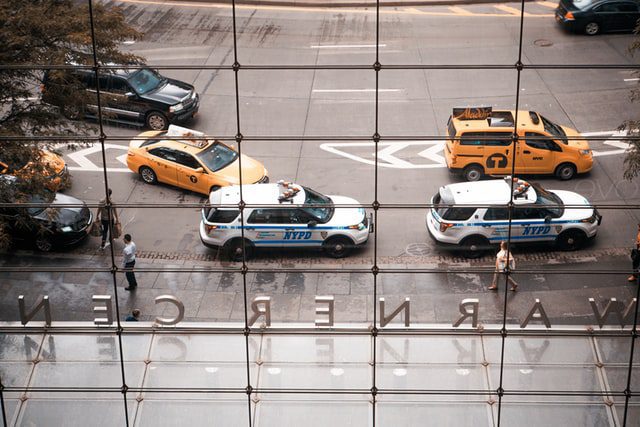
Photo by Ethan Hoover on Unsplash
Effective July 1, 2019, Virginia Code § 46.2-861.1 (known as the “Move Over” law) increases the penalties for failing to move over for an emergency vehicle that is displaying flashing, blinking, or alternating red, blue or amber lights. The change in law makes the offense a reckless driving charge, a class 1 misdemeanor, when applied to most emergency vehicles, which means that penalties now include the possibility of jail time, a license suspension of up to 6 months (or more in certain situations of injury or death), and a fine of up to $2,500. The law requires proof of certain elements which I will explain below, but the safe thing to do when you see an emergency vehicle with flashing lights is to move over one lane when passing or slow down if it is unsafe to switch lanes.
To be precise, the title given to the code section mentions yielding the right-of-way or reducing speed, but the actual text of Virginia Code § 46.2-861.1 doesn’t actually mention the words “move over” or “reduce speed” specifically.
What does the law require? It says that the driver shall, “on a highway having at least four lanes, at least two of which are intended for traffic proceeding as the approaching vehicle, proceed with caution and, if reasonable, with due regard for safety and traffic conditions, yield the right-of-way by making a lane change into a lane not adjacent to the stationary vehicle or (ii) if changing lanes would be unreasonable or unsafe, proceed with due caution and maintain a safe speed for highway conditions.” I suppose judges would understand “maintain a safe speed for highway conditions” to mean to slow down.
If in court, the officer or Commonwealth does not prove the elements of the crime, a case should be dismissed. The law applies when:
-
-
-
- A person is driving a motor vehicle
- On a highway having at least four lanes, at least two of which are intended for traffic proceeding as the approaching vehicle
- Approaching a stationary vehicle with flashing, blinking, or alternating blue, red, or amber light or lights as applied to
-
- § 46.2-1022 (Law enforcement, Virginia National Guard, etc.)
- § 46.2-1023 (Fire truck, ambulance, game warden, etc.)
- § 46.2-1024 (A private vehicle owned by a fireman, rescue squad volunteer or police chaplain)
- or subsection B of § 46.2-1026 (public utility company for the purpose of repairing, installing, or maintaining electric or natural gas utility equipment or service)
-
- That is displaying flashing, blinking, or alternating red, blue, or amber lights
-
-
However, the law keeps it a traffic infraction instead of a reckless driving classification when applied to these vehicles:
-
-
-
- Tow truck or maintenance vehicle (46.2-1025(A)(1))
- Highway or utility construction vehicle (46.2-1025(A)(2))
-
-
Furthermore, even when the law applies, we have seen judges show mercy due to mitigating circumstances and reduce a charge to improper driving or another non-criminal offense. One judge we have seen will ask a police officer whether he was outside or inside the vehicle at the time of the offense in order to determine if a reduction out of reckless driving is warranted. If you are facing a reckless driving charge for passing a stationary emergency vehicle, it may be advisable to produce your driving record and do driving school before court to try to earn mercy.
The text of the law goes like this:
§ 46.2-861.1. Drivers to yield right-of-way or reduce speed when approaching stationary vehicles displaying certain warning lights on highways; penalties.
A. The driver of any motor vehicle, upon approaching a stationary vehicle that is displaying a flashing, blinking, or alternating blue, red, or amber light or lights as provided in § 46.2-1022, 46.2-1023, or 46.2-1024 or subsection B of § 46.2-1026 shall (i) on a highway having at least four lanes, at least two of which are intended for traffic proceeding as the approaching vehicle, proceed with caution and, if reasonable, with due regard for safety and traffic conditions, yield the right-of-way by making a lane change into a lane not adjacent to the stationary vehicle or (ii) if changing lanes would be unreasonable or unsafe, proceed with due caution and maintain a safe speed for highway conditions. A violation of any provision of this subsection is reckless driving.
B. The driver of any motor vehicle, upon approaching a stationary vehicle that is displaying a flashing, blinking, or alternating amber light or lights as provided in subdivision A 1 or 2 of § 46.2-1025 shall (i) on a highway having at least four lanes, at least two of which are intended for traffic proceeding as the approaching vehicle, proceed with caution and, if reasonable, with due regard for safety and traffic conditions, yield the right-of-way by making a lane change into a lane not adjacent to the stationary vehicle or (ii) if changing lanes would be unreasonable or unsafe, proceed with due caution and maintain a safe speed for highway conditions. A violation of any provision of this subsection shall be punishable as a traffic infraction.
C. If the violation resulted in damage to property of another person, the court may, in addition, order the suspension of the driver’s privilege to operate a motor vehicle for not more than one year. If the violation resulted in injury or death to another person, the court may, in addition to any other penalty imposed, order the suspension of the driver’s privilege to operate a motor vehicle for not more than two years.
D. The provisions of this section shall not apply in highway work zones as defined in § 46.2-878.1.